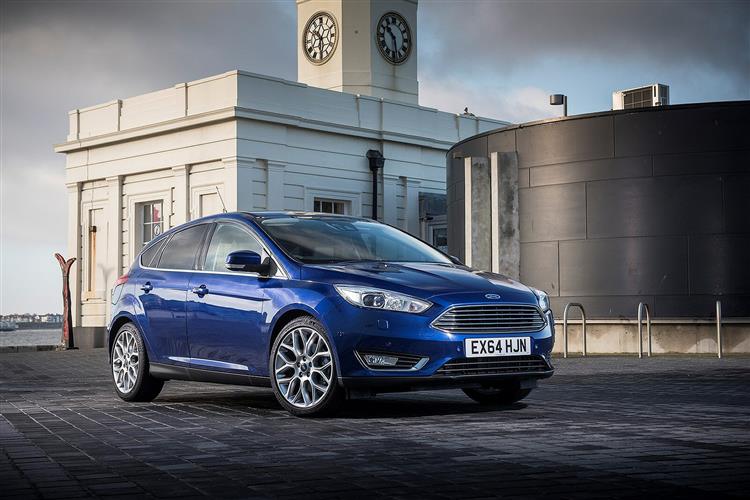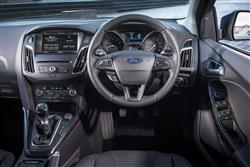How will you view?
This is a sample, and will stop after 30 seconds.
RENEWED FOCUS (some text hidden) SECTIONED_new_fordfocus_2015
By Jonathan Crouch
Introductionword count: 108
The Ford Focus evolved in third generation guise, then further smartened up its act in the revised MK3 form launched in 2014 - the car we evaluate here as a used buy. The idea was to offer slicker looks, higher interior quality and extra technology. Plus with this re-design, the Focus also delivered greater efficiency beneath the bonnet thanks to the addition of a hi-tech range of 1.5-litre petrol and diesel engines. The best part though, is that this car still remains as rewarding to drive as it's always been. The Focus might have grown up a little in this form, but it certainly hasn't lost its spark.
Modelsword count: 22
5dr Hatch / Estate (Petrol - 1.6, 1.5, 1.0 EcoBoost, 1.5 EcoBoost, 2.0 EcoBoot, 2.3 EcoBoost / 1.5 & 1.6 TDCi diesel)
Historyword count: 491
The problem with success is that it creates an expectation. Whether it's an author looking to repeat the storming sales of a bestselling debut novel or a rock group recording that tricky second album, prolonging success is just as hard as winning it in the first place. Just ask Ford. This improved third generation Focus model, launched in 2015, served as a case study in clinging onto hard-won gains. To understand its significance, we'll need to press the rewind button for a moment and shuttle back to 1997. Ford's family hatch contender during this period was the fifth generation Escort, a car so all-encompassingly woeful that the brand was almost embarrassed to sell it. When the time came for a replacement, we all expected something better. What we got in the Focus model first launched in 1998 was something much, much more than that, a car that, at a stroke, offered arguably the biggest step forward in family car design the market has ever seen. Here at last was technology directed firmly at the man in the street who, in this apparently humble family hatchback, could experience a car more entertaining and rewarding to drive than almost anything this side of a sizeable lottery win. It was asking a lot for the MK2 model we saw in 2005 to repeat such a seismic step forward but that second generation Focus was still quite good enough to remain acclaimed as the driver's choice against rival Astras and Golfs that made up for their dynamic failings with a better ride and a more luxurious big car feel. These were attributes the Focus needed too and when it came to developing the MK3 version, first launched early in 2011, Ford tried to provide them without compromising the car's class-leading handling. Here was a design with plenty to live up to, the brand's first truly global model, offered for sale in over 120 countries and aiming to offer family hatchback buyers the last word in comfort, convenience, eco-friendliness and hi-tech compatibility with the modern world. Lofty ideals that looked credibly realised back in 2011. By 2014 though, the market landscape in the closely-fought family hatchback sector looked somewhat different, the intervening years having seen the launch of impressive new competitors like new generation versions of Peugeot's 308, SEAT's Leon and, most significantly, the Volkswagen Golf. In comparison, the Focus was starting to age a little. Hence the need for the far-reaching package of late-2014 updates that brought us the much improved third generation version of this Ford that we're going to look at here. It was cheaper to run, safer to drive and smarter both to look at and to sit in. It did, in short, promise the kind of significant step forward that was absolutely necessary in retaining Ford's UKs sales leadership in this segment. This car sold until the early Summer of 2018, when it was replaced by an all-new fourth generation model.
What You Getword count: 1092
It's only when you put this improved MK3 Focus next to the original third generation version that you realise just how much more expensive this model looks. Ford's objective was to take this car closer to its arch-rival Volkswagen's Golf in terms of visual sophistication and make switching into a Focus a little easier for those afflicted with any degree of badge snobbery. The most obvious visual change was the addition of an Aston Martin-style trapezoidal front grille, there to give the front end a more distinctive look also emphasised by subtle chrome detailing and slimmer, smarter front headlights and re-styled foglamps. It was all part of a design approach that aimed to build upon the lower, wider stance delivered by the more dynamically-sculpted bonnet. Moving round to the sides, loyal Focus folk will also take in the sleeker flanks and redesigned alloy wheels - but then such detail changes are of course relatively easy to make. What Ford's designers really wanted to do with this updated model was to correct its predecessor's biggest issue, a general lack of boot space. Since this car had to retain the same dimensions and basic silhouette of its predecessor, they couldn't do that. Instead, the brand had to content itself with a mere styling nip and tuck at the rear that gave us a revised tailgate arrangement and thinner tail lamps. As a result, Ford dealerships had to continue to direct potential Focus buyers prioritising bootspace to the estate version, the only other bodystyle alternative the range offered to the conventional five-door hatch. Lift the wide-opening tailgate on the hatch model and up to the cargo shelf, there's 316-litres on offer - and you only get that if you choose a car whose original owner (rather unwisely) chose to do without the optional full-sized spare wheel. With that fitted, the capacity falls to just 277-litres, which is getting into Fiesta-style supermini territory. In the rare all-electric model, that figure falls to just 237-litres. Overall with a mainstream Focus model, the bottom line is that a Golf would give you 20% more room and something comparable like a Peugeot 308 would give you nearly twice as much space. Will that be an issue for potential Focus customers? Well, it didn't seem to be with the original version of this car. Plus of course you can push the 60/40 split folding rear bench forward, though you do have to flip the seat bases up first, which is a bit fiddly. Once that process is completed, you get a completely flat load area and as much as 1,262-litres can be freed up, provided that spare wheel isn't fitted, or 1,176-litres if it has been. Should more room than that be required, there is, as we've said, always the sleek estate version to consider. Though this rides on the same wheelbase, its extra 200mm of rear overhang allows cargo capacity without a full-sized spare to rise to a very decent 476-litres. Rear seat space is closer to the class standard. Wide-opening doors help to access it and some owners fitted them with neat edge protectors that pop out to prevent carpark dings. Inside, fears that the curved rear roofline will severely compromise headroom turn out to be groundless, though the wedgy side profile does hem you in with a slightly higher windowline. You sit high-ishly positioned for a good view of the road ahead and both head and legroom are adequate, even for a couple of six-footers. As usual with cars in this class, three adults will be rather squashed here, but a trip of kids should find the space provided quite sufficient. And up-front? Well, with the original first generation version of this car, Ford made great play about having created a design that could be comfortably driven by anyone between four foot nine and six foot nine and ever since, the Focus has remained a great choice for any size or shape of potential owner. True to form, this version feels right from the moment you take a seat thanks to near-perfect driver positioning that sees you ideally placed to view the way ahead from a low-ish, road-focused stance. As with the original version of this MK3 model, you're sat in front of a three-spoke leather-trimmed multi-function steering wheel through which you view a pair of deeply recessed blue-lit instrument dials that look good and are easy on the eyes at night. What's different with this revised MK3 design is that between these has been inserted a bigger, clearer and smarter trip computer display that's far better at covering off key information at a glance. A more significant change though, with this updated model lay in Ford's efforts to combat the dreaded scourge of button clutter. In the original MK3 version of this car, you could have steering wheel controls dealing with no fewer than 23 functions, enough to give even the most determined technophobe handbook fatigue. With this revised design, though there are still quite a few switches spread around the dash, they're larger, classier and easier to get to grips with. The addition of extra infotainment screen technology certainly played its part in helping the designers simplify the control layout, with plusher trim levels getting a smart 8-inch colour touchscreen, the portal for controlling Ford's award-winning SYNC infotainment system. Through SYNC, you can control audio, navigation, climate control and 'phone functions via voice or touchscreen buttons. We'd master the voice functionality first, as the buttons can be rather fiddly to use. Once you're au fait with this, you can issue simple 'one shot' commands, like 'play song' to play a track from a CD or even 'I'm hungry' to bring up a list of local restaurants on the split-screen satellite navigation system. The SYNC system, was optional on lower trim levels and is well worth seeking out as without it, you're provided only with a much smaller 4.2” display operable only with more conventional button-orientated functionality. Whatever your choice of Focus variant, you'll find trim quality much improved over earlier models in a move Ford had to make to keep up with the segment-leadingly classy Golf. There's still more that Ford could have done, but the addition of soft-touch plastics, black satin trim, chrome detailing and higher quality climate-control switches did wonders for this model's cabin ambience. This is a practical place to be too. The redesigned centre console offered more space as well as a sliding integrated armrest. Plus there's a drink-holding area that can take a one-litre bottle and a 0.4-litre cup simultaneously.
To see the full road test text contact us on 0330 0020 227
Pictures (high res disabled)

.jpg)
|
.jpg)
|
.jpg)
| |||
.jpg)
|

|
Scoring (subset of scores)
Category: Compact Family Cars
| Performance | |
| Handling | |
| Comfort | |
| Space | |
| Styling, Build, Value, Equipment, Depreciation, Handling, Insurance and Total scores are available with our full data feed. | |



